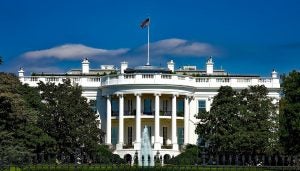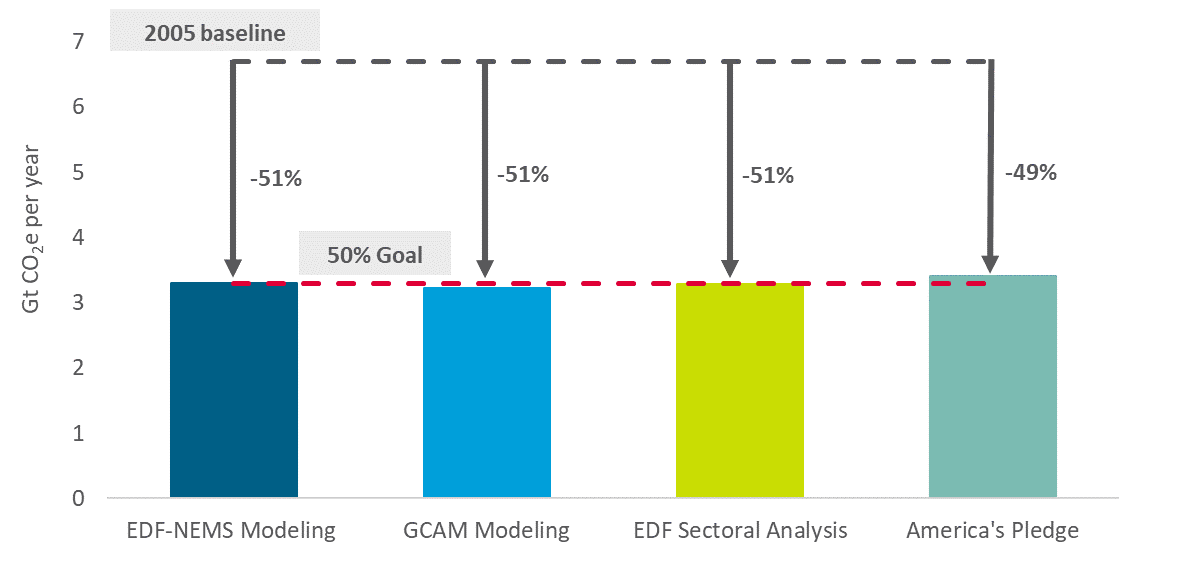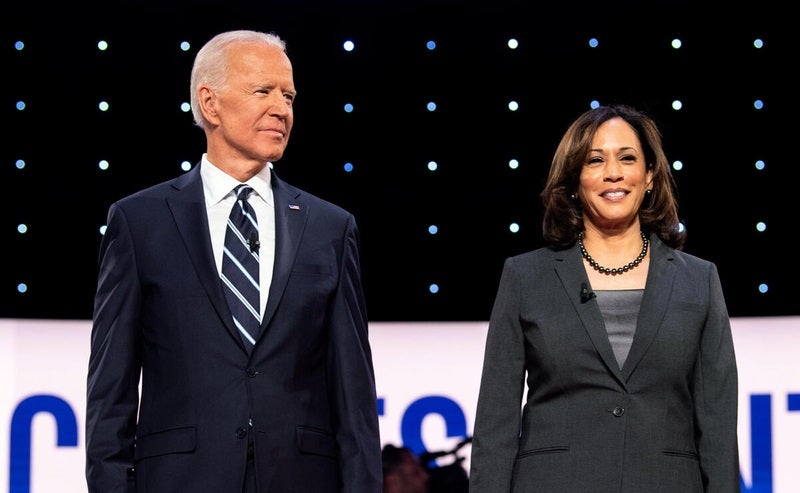
A bold new commitment to the Paris Agreement is achievable – and essential for U.S. leadership
This blog post was co-authored with Nat Keohane, Senior Vice President for Climate at EDF.
Now that the United States is officially back in the Paris Agreement, after four years of climate inaction and denial, all eyes are on the Biden administration to see whether it will meet the moment by putting forward a new emissions reduction commitment that is both ambitious and credible. In order to hit both marks, the administration should commit to cut total net greenhouse gas emissions by at least 50% below 2005 levels by 2030 – a target that is consistent with the science and President Biden’s goal of a net-zero economy by 2050, commensurate with commitments of other advanced economies, and one that many state leaders, businesses, advocates and others are already calling for.
This year’s UN climate talks, known as COP26 and set to take place in November, will be a proving ground for the Paris Agreement framework. Countries must come to the table with more ambitious climate targets known as Nationally Determined Contributions, or NDCs. Collectively, these NDCs must put the world on a path consistent with the Paris Agreement’s objective of limiting global temperature rise to well below 2°C and pursuing efforts to limit the increase to 1.5°C.
The United States has the chance to regain a position as a global leader on climate – and to galvanize climate action around the world – by setting an ambitious target that meets the scale of the climate crisis. The new U.S. NDC must also be credible – meaning that one or more technically and economically viable policy pathways can be identified to achieve it. Using a range of analyses, a new EDF report demonstrates how a bold new commitment of reducing total net GHG emissions at least 50% below 2005 levels by 2030 is achievable through multiple policy pathways – and that charting an ambitious path on climate is essential for growing a stronger and more equitable, clean U.S. economy.
Raising the bar on global ambition
The stakes for the climate crisis are enormously high. Scientists warn that temperature rise above the 1.5 to 2°C range heightens the risk of disastrous outcomes for communities all over the world – from collapsing ecosystems to deadly extreme weather events. Unfortunately, despite action by other countries, states, and local governments, the Trump administration’s abdication of federal leadership set back global efforts to make meaningful progress on climate, damaging America’s reputation in the process.
By taking swift all-in action to invest in clean technologies and industries, the United States can position itself to be a strong competitor in the rapidly growing global clean energy economy, while creating healthier air and good-paying jobs that promote equity at home. And as the largest historical contributor to climate change, and a wealthy advanced economy, the United States has a moral imperative to act aggressively to reduce its own pollution. A commitment to cut emissions at least 50% below 2005 levels by 2030 would put the United States strongly on the path to net zero by 2050 and would be comparable to those put forward by other developed countries, like the European Union and the U.K.
Going all in: Cutting emissions at least 50% by 2030 is achievable
To truly accelerate the global race against the climate crisis, the U.S. must set a target that is not only ambitious, but credible. It must be clear to the rest of the world that a 50% reduction can be reached – and, critically, that the White House is willing to muster the political will to pursue it.
As the new EDF report shows, a range of analyses from different sources demonstrates how a 50% target is within reach with swift all-in action. These include modeling from the Center for Global Sustainability at University of Maryland, America’s Pledge, and two EDF analyses, one of which relies on modeling by the Rhodium Group – and there is strong evidence that even greater reductions than those reflected in these analyses are possible. Although these analyses use different modeling and policy pathways, they reveal several common key insights.
- A whole-of-government approach is needed: Achieving this goal requires leveraging every tool in our toolbox, including advancing a suite of robust climate and clean air protections under existing law targeting the power and transportation sectors as well as methane emissions from oil and gas; directing significant economic recovery dollars towards accelerated deployment of clean electricity and electric vehicles; enacting new legislation that limits pollution from the power sector, such as a clean electricity standard; increasing federal investment in innovation and demonstration of promising emerging technologies; and expanding state, local and businesses action.
A range of analyses demonstrate that the United States can
cut GHG emissions at least 50% below 2005 level by 2030

- Economy-wide limits on pollution would supercharge reductions and ensure we meet our goals: While analyses demonstrate that it is possible to get to at least 50% with sector-specific action alone, an enforceable declining limit and a price on emissions across the economy would serve as a critical backstop mechanism to guarantee the U.S. hits both its near-term and long-term goals. It would also supercharge and align efforts to cut pollution across all sectors and industries, moving us more quickly and affordably towards our net zero goal.
- Strong early action is critical: A front-loaded emissions trajectory – reducing more emissions in earlier years than implied by the straight line path to net-zero – comes with significant benefits over all timescales. Early mitigation of powerful short-lived climate pollutants, such as methane, can significantly slow down the rate of warming in the near-term. This is why the administration should – as a component of the new NDC – put forward an explicit commitment to reduce methane emissions economy-wide by 40% below 2005 levels by 2030, with emphasis on the oil and gas sector, which the International Energy Agency says can achieve a 75% reduction in methane pollution with technologies available to do it today. At the same time, early mitigation of long-lived climate pollutants, such as CO2, is critical for achieving eventual climate stabilization. Early reductions also increase the chances of meeting the NDC target and allow more flexibility down the road when we tackle more difficult-to-abate emissions from sectors like heavy industry and aviation.
- Cleaning up the power sector is key: Across all the analyses, the bulk of emissions reductions by 2030 come from the power sector, underscoring how early action to meet Biden’s clean electricity goal is absolutely essential. Decarbonizing the power sector as quickly as possible is critical to enable swift and broad electrification of other sectors like transportation with clean power.
Charting an ambitious path can drive a thriving, more equitable economy
The U.S. has much to gain from all-in action to meet a 50% or more reduction by 2030 in this pivotal decade. Beyond protecting Americans from the most damaging climate impacts, aggressive action can bring significant benefits to the U.S. economy, while driving progress on public health and equity.
Expanding clean and low-carbon industries can support millions of jobs and position the U.S. to be a strong competitor in the global 21st century clean economy. Many industries are already making bold moves – like automakers, which plan to spend more than $250 billion through 2030 developing electric vehicle models. Importantly, investments in clean power, transportation and manufacturing through stimulus and recovery legislation can help rebuild the economy in the wake of the COVID-19 pandemic. And prioritizing clean energy investments that simultaneously create jobs and deliver health benefits in frontline communities – including low-income communities, communities of color, and communities transitioning off of reliance on the fossil fuel economy – can help build a more equitable economy for all Americans.
There are many pathways to get to 50% reductions or greater by 2030 and net zero by 2050 – and how we get there matters immensely. Climate policy to reach this goal can and should be designed to expand access to economic opportunity, reduce exposure to harmful air pollution, and empower American workers in every community.
Read the full EDF report: Recapturing U.S. Leadership on Climate: Setting an Ambitious and Credible Nationally Determined Contribution.
This piece is a part of a blog series that explores what it will take to restore and strengthen climate leadership both across the country and on the global stage.












